Technology Enterprises Ltd: Intangible Assets and Financial Statements
VerifiedAdded on 2020/10/23
|9
|2417
|191
Report
AI Summary
This report examines Technology Enterprises Ltd's accounting practices concerning a new battery design project. It analyzes the application of AASB 138 and IAS 38 to the company's intangible assets, including research and development costs. The report details how the project should be accounted for in the financial statements, specifically focusing on the treatment of expenses and the valuation of the new design. It also explores the extent to which the rules and regulations of AASB 138 and IAS 38 may impact the comparability of financial statements. Furthermore, the report provides recommendations to the CEO of Technology Enterprises Ltd. on mitigating concerns regarding investor interpretation of the financial information, suggesting the use of the efficient market hypothesis to aid stakeholders in their analysis. The report highlights the importance of complying with accounting standards for accurate and transparent financial reporting.
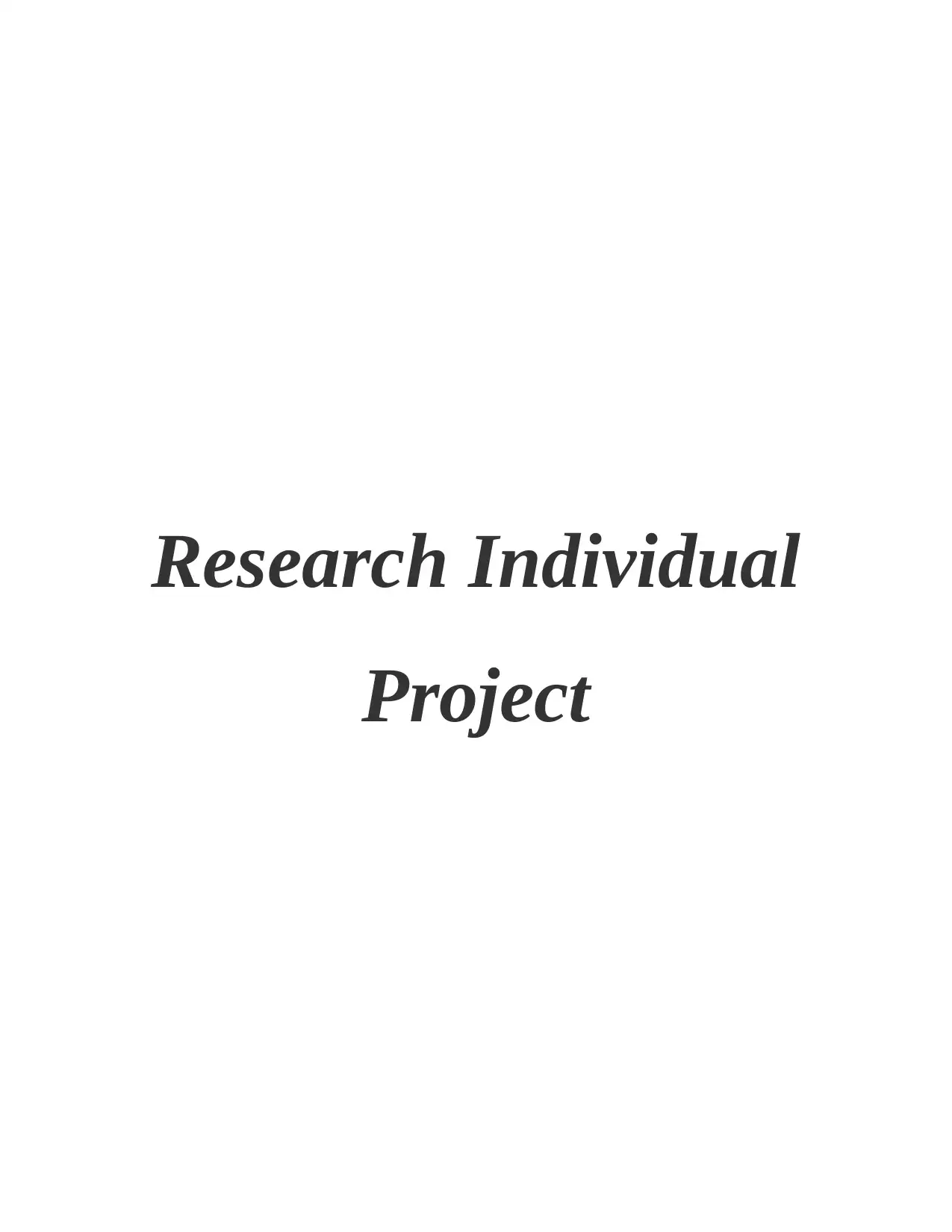
Research Individual
Project
Project
Paraphrase This Document
Need a fresh take? Get an instant paraphrase of this document with our AI Paraphraser
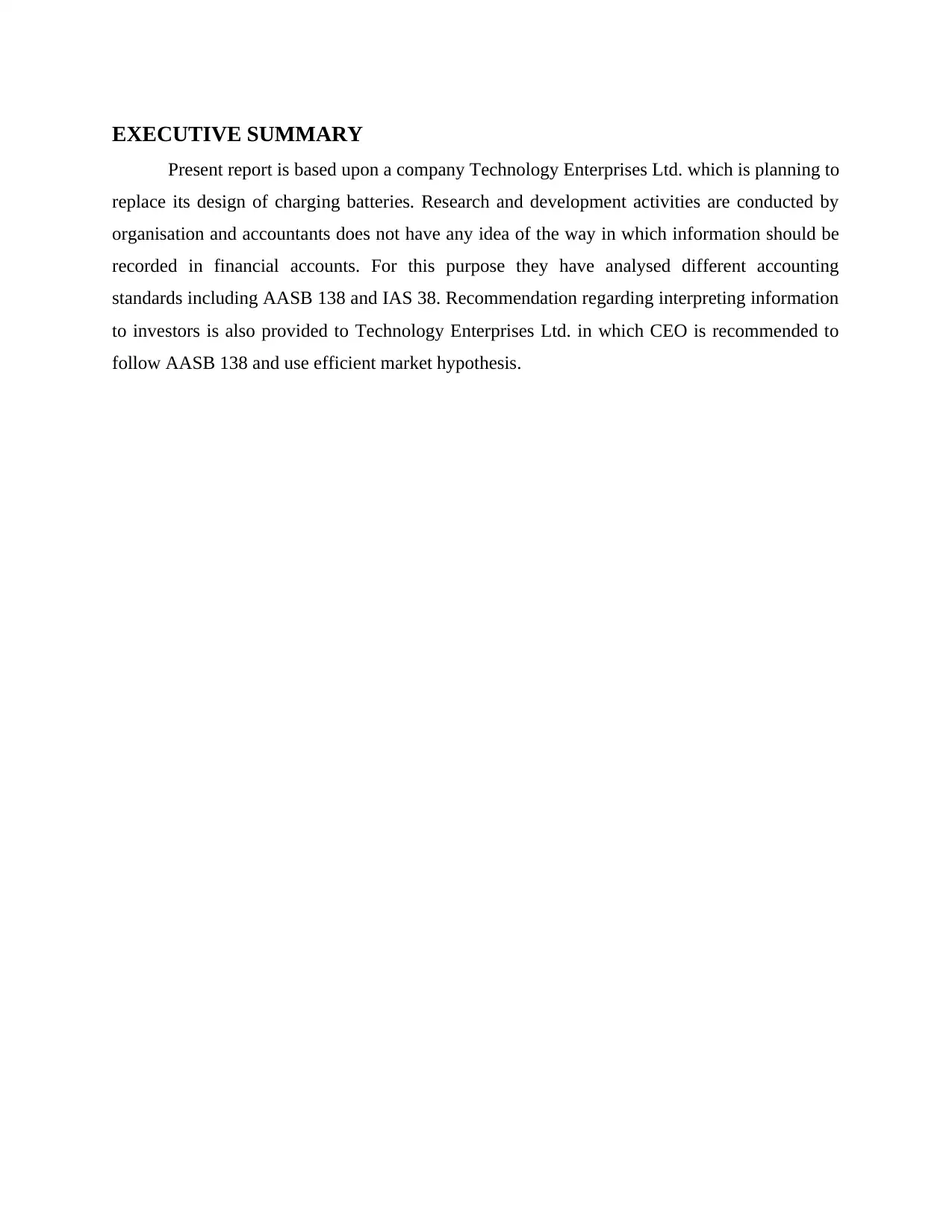
EXECUTIVE SUMMARY
Present report is based upon a company Technology Enterprises Ltd. which is planning to
replace its design of charging batteries. Research and development activities are conducted by
organisation and accountants does not have any idea of the way in which information should be
recorded in financial accounts. For this purpose they have analysed different accounting
standards including AASB 138 and IAS 38. Recommendation regarding interpreting information
to investors is also provided to Technology Enterprises Ltd. in which CEO is recommended to
follow AASB 138 and use efficient market hypothesis.
Present report is based upon a company Technology Enterprises Ltd. which is planning to
replace its design of charging batteries. Research and development activities are conducted by
organisation and accountants does not have any idea of the way in which information should be
recorded in financial accounts. For this purpose they have analysed different accounting
standards including AASB 138 and IAS 38. Recommendation regarding interpreting information
to investors is also provided to Technology Enterprises Ltd. in which CEO is recommended to
follow AASB 138 and use efficient market hypothesis.
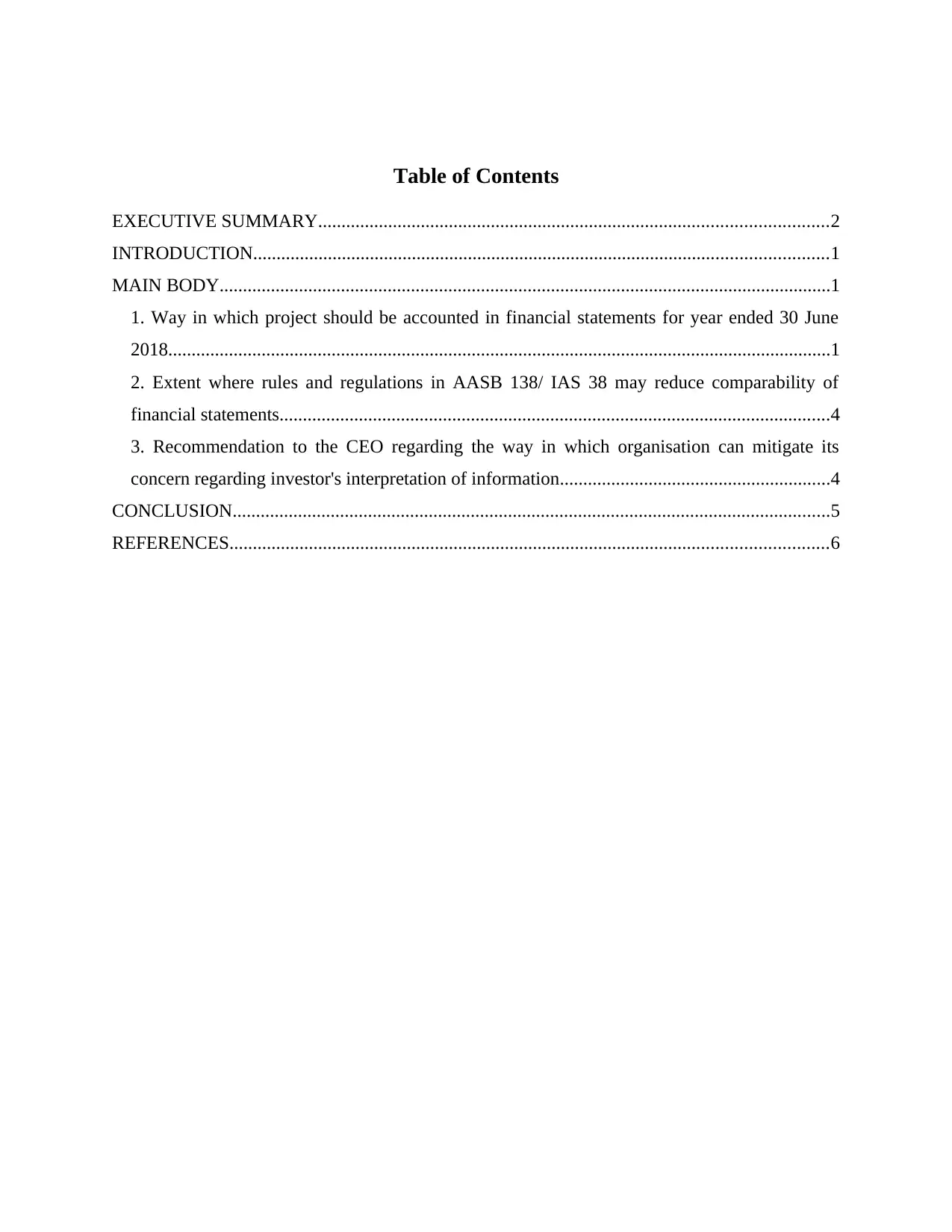
Table of Contents
EXECUTIVE SUMMARY.............................................................................................................2
INTRODUCTION...........................................................................................................................1
MAIN BODY...................................................................................................................................1
1. Way in which project should be accounted in financial statements for year ended 30 June
2018..............................................................................................................................................1
2. Extent where rules and regulations in AASB 138/ IAS 38 may reduce comparability of
financial statements......................................................................................................................4
3. Recommendation to the CEO regarding the way in which organisation can mitigate its
concern regarding investor's interpretation of information..........................................................4
CONCLUSION................................................................................................................................5
REFERENCES................................................................................................................................6
EXECUTIVE SUMMARY.............................................................................................................2
INTRODUCTION...........................................................................................................................1
MAIN BODY...................................................................................................................................1
1. Way in which project should be accounted in financial statements for year ended 30 June
2018..............................................................................................................................................1
2. Extent where rules and regulations in AASB 138/ IAS 38 may reduce comparability of
financial statements......................................................................................................................4
3. Recommendation to the CEO regarding the way in which organisation can mitigate its
concern regarding investor's interpretation of information..........................................................4
CONCLUSION................................................................................................................................5
REFERENCES................................................................................................................................6
⊘ This is a preview!⊘
Do you want full access?
Subscribe today to unlock all pages.

Trusted by 1+ million students worldwide
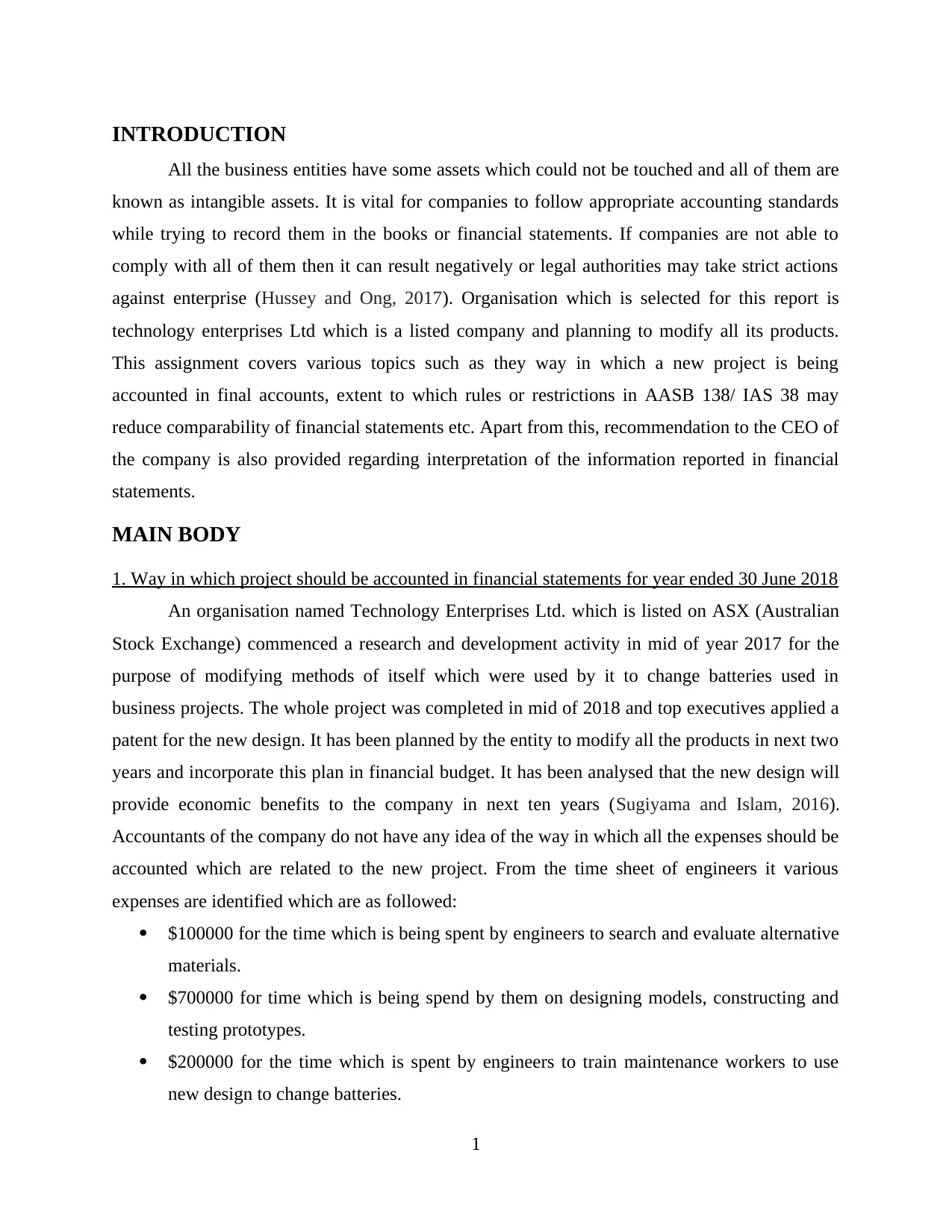
INTRODUCTION
All the business entities have some assets which could not be touched and all of them are
known as intangible assets. It is vital for companies to follow appropriate accounting standards
while trying to record them in the books or financial statements. If companies are not able to
comply with all of them then it can result negatively or legal authorities may take strict actions
against enterprise (Hussey and Ong, 2017). Organisation which is selected for this report is
technology enterprises Ltd which is a listed company and planning to modify all its products.
This assignment covers various topics such as they way in which a new project is being
accounted in final accounts, extent to which rules or restrictions in AASB 138/ IAS 38 may
reduce comparability of financial statements etc. Apart from this, recommendation to the CEO of
the company is also provided regarding interpretation of the information reported in financial
statements.
MAIN BODY
1. Way in which project should be accounted in financial statements for year ended 30 June 2018
An organisation named Technology Enterprises Ltd. which is listed on ASX (Australian
Stock Exchange) commenced a research and development activity in mid of year 2017 for the
purpose of modifying methods of itself which were used by it to change batteries used in
business projects. The whole project was completed in mid of 2018 and top executives applied a
patent for the new design. It has been planned by the entity to modify all the products in next two
years and incorporate this plan in financial budget. It has been analysed that the new design will
provide economic benefits to the company in next ten years (Sugiyama and Islam, 2016).
Accountants of the company do not have any idea of the way in which all the expenses should be
accounted which are related to the new project. From the time sheet of engineers it various
expenses are identified which are as followed:
$100000 for the time which is being spent by engineers to search and evaluate alternative
materials.
$700000 for time which is being spend by them on designing models, constructing and
testing prototypes.
$200000 for the time which is spent by engineers to train maintenance workers to use
new design to change batteries.
1
All the business entities have some assets which could not be touched and all of them are
known as intangible assets. It is vital for companies to follow appropriate accounting standards
while trying to record them in the books or financial statements. If companies are not able to
comply with all of them then it can result negatively or legal authorities may take strict actions
against enterprise (Hussey and Ong, 2017). Organisation which is selected for this report is
technology enterprises Ltd which is a listed company and planning to modify all its products.
This assignment covers various topics such as they way in which a new project is being
accounted in final accounts, extent to which rules or restrictions in AASB 138/ IAS 38 may
reduce comparability of financial statements etc. Apart from this, recommendation to the CEO of
the company is also provided regarding interpretation of the information reported in financial
statements.
MAIN BODY
1. Way in which project should be accounted in financial statements for year ended 30 June 2018
An organisation named Technology Enterprises Ltd. which is listed on ASX (Australian
Stock Exchange) commenced a research and development activity in mid of year 2017 for the
purpose of modifying methods of itself which were used by it to change batteries used in
business projects. The whole project was completed in mid of 2018 and top executives applied a
patent for the new design. It has been planned by the entity to modify all the products in next two
years and incorporate this plan in financial budget. It has been analysed that the new design will
provide economic benefits to the company in next ten years (Sugiyama and Islam, 2016).
Accountants of the company do not have any idea of the way in which all the expenses should be
accounted which are related to the new project. From the time sheet of engineers it various
expenses are identified which are as followed:
$100000 for the time which is being spent by engineers to search and evaluate alternative
materials.
$700000 for time which is being spend by them on designing models, constructing and
testing prototypes.
$200000 for the time which is spent by engineers to train maintenance workers to use
new design to change batteries.
1
Paraphrase This Document
Need a fresh take? Get an instant paraphrase of this document with our AI Paraphraser
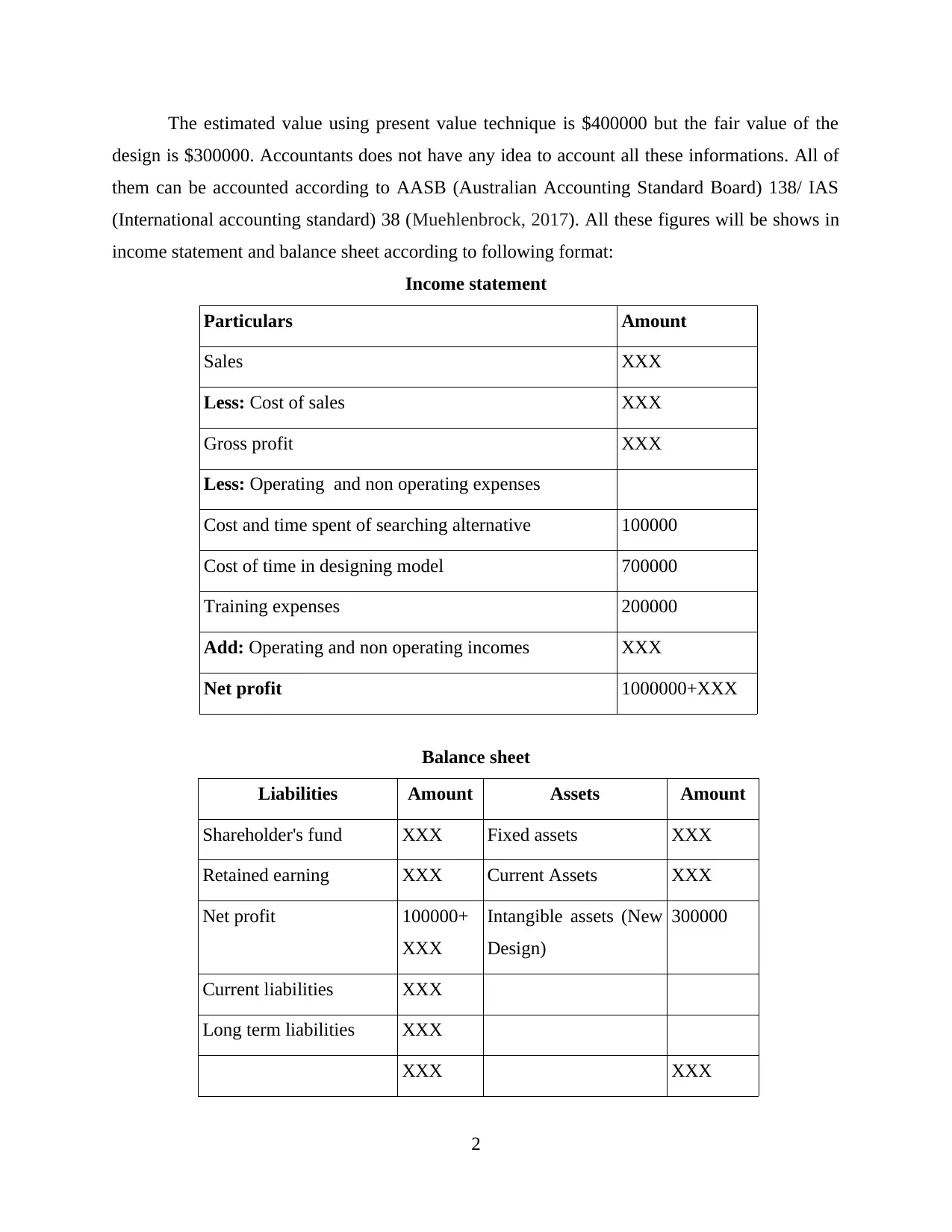
The estimated value using present value technique is $400000 but the fair value of the
design is $300000. Accountants does not have any idea to account all these informations. All of
them can be accounted according to AASB (Australian Accounting Standard Board) 138/ IAS
(International accounting standard) 38 (Muehlenbrock, 2017). All these figures will be shows in
income statement and balance sheet according to following format:
Income statement
Particulars Amount
Sales XXX
Less: Cost of sales XXX
Gross profit XXX
Less: Operating and non operating expenses
Cost and time spent of searching alternative 100000
Cost of time in designing model 700000
Training expenses 200000
Add: Operating and non operating incomes XXX
Net profit 1000000+XXX
Balance sheet
Liabilities Amount Assets Amount
Shareholder's fund XXX Fixed assets XXX
Retained earning XXX Current Assets XXX
Net profit 100000+
XXX
Intangible assets (New
Design)
300000
Current liabilities XXX
Long term liabilities XXX
XXX XXX
2
design is $300000. Accountants does not have any idea to account all these informations. All of
them can be accounted according to AASB (Australian Accounting Standard Board) 138/ IAS
(International accounting standard) 38 (Muehlenbrock, 2017). All these figures will be shows in
income statement and balance sheet according to following format:
Income statement
Particulars Amount
Sales XXX
Less: Cost of sales XXX
Gross profit XXX
Less: Operating and non operating expenses
Cost and time spent of searching alternative 100000
Cost of time in designing model 700000
Training expenses 200000
Add: Operating and non operating incomes XXX
Net profit 1000000+XXX
Balance sheet
Liabilities Amount Assets Amount
Shareholder's fund XXX Fixed assets XXX
Retained earning XXX Current Assets XXX
Net profit 100000+
XXX
Intangible assets (New
Design)
300000
Current liabilities XXX
Long term liabilities XXX
XXX XXX
2
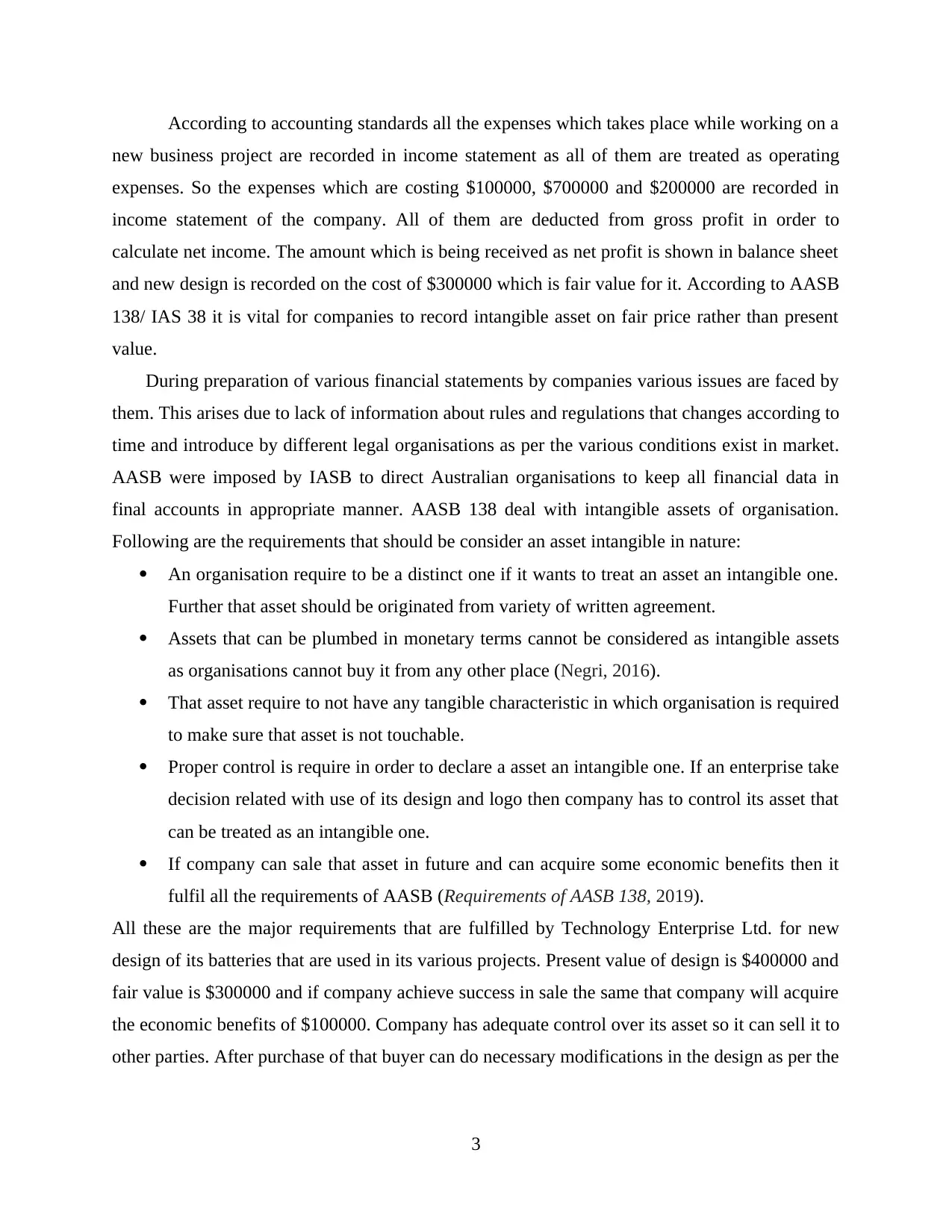
According to accounting standards all the expenses which takes place while working on a
new business project are recorded in income statement as all of them are treated as operating
expenses. So the expenses which are costing $100000, $700000 and $200000 are recorded in
income statement of the company. All of them are deducted from gross profit in order to
calculate net income. The amount which is being received as net profit is shown in balance sheet
and new design is recorded on the cost of $300000 which is fair value for it. According to AASB
138/ IAS 38 it is vital for companies to record intangible asset on fair price rather than present
value.
During preparation of various financial statements by companies various issues are faced by
them. This arises due to lack of information about rules and regulations that changes according to
time and introduce by different legal organisations as per the various conditions exist in market.
AASB were imposed by IASB to direct Australian organisations to keep all financial data in
final accounts in appropriate manner. AASB 138 deal with intangible assets of organisation.
Following are the requirements that should be consider an asset intangible in nature:
An organisation require to be a distinct one if it wants to treat an asset an intangible one.
Further that asset should be originated from variety of written agreement.
Assets that can be plumbed in monetary terms cannot be considered as intangible assets
as organisations cannot buy it from any other place (Negri, 2016).
That asset require to not have any tangible characteristic in which organisation is required
to make sure that asset is not touchable.
Proper control is require in order to declare a asset an intangible one. If an enterprise take
decision related with use of its design and logo then company has to control its asset that
can be treated as an intangible one.
If company can sale that asset in future and can acquire some economic benefits then it
fulfil all the requirements of AASB (Requirements of AASB 138, 2019).
All these are the major requirements that are fulfilled by Technology Enterprise Ltd. for new
design of its batteries that are used in its various projects. Present value of design is $400000 and
fair value is $300000 and if company achieve success in sale the same that company will acquire
the economic benefits of $100000. Company has adequate control over its asset so it can sell it to
other parties. After purchase of that buyer can do necessary modifications in the design as per the
3
new business project are recorded in income statement as all of them are treated as operating
expenses. So the expenses which are costing $100000, $700000 and $200000 are recorded in
income statement of the company. All of them are deducted from gross profit in order to
calculate net income. The amount which is being received as net profit is shown in balance sheet
and new design is recorded on the cost of $300000 which is fair value for it. According to AASB
138/ IAS 38 it is vital for companies to record intangible asset on fair price rather than present
value.
During preparation of various financial statements by companies various issues are faced by
them. This arises due to lack of information about rules and regulations that changes according to
time and introduce by different legal organisations as per the various conditions exist in market.
AASB were imposed by IASB to direct Australian organisations to keep all financial data in
final accounts in appropriate manner. AASB 138 deal with intangible assets of organisation.
Following are the requirements that should be consider an asset intangible in nature:
An organisation require to be a distinct one if it wants to treat an asset an intangible one.
Further that asset should be originated from variety of written agreement.
Assets that can be plumbed in monetary terms cannot be considered as intangible assets
as organisations cannot buy it from any other place (Negri, 2016).
That asset require to not have any tangible characteristic in which organisation is required
to make sure that asset is not touchable.
Proper control is require in order to declare a asset an intangible one. If an enterprise take
decision related with use of its design and logo then company has to control its asset that
can be treated as an intangible one.
If company can sale that asset in future and can acquire some economic benefits then it
fulfil all the requirements of AASB (Requirements of AASB 138, 2019).
All these are the major requirements that are fulfilled by Technology Enterprise Ltd. for new
design of its batteries that are used in its various projects. Present value of design is $400000 and
fair value is $300000 and if company achieve success in sale the same that company will acquire
the economic benefits of $100000. Company has adequate control over its asset so it can sell it to
other parties. After purchase of that buyer can do necessary modifications in the design as per the
3
⊘ This is a preview!⊘
Do you want full access?
Subscribe today to unlock all pages.

Trusted by 1+ million students worldwide
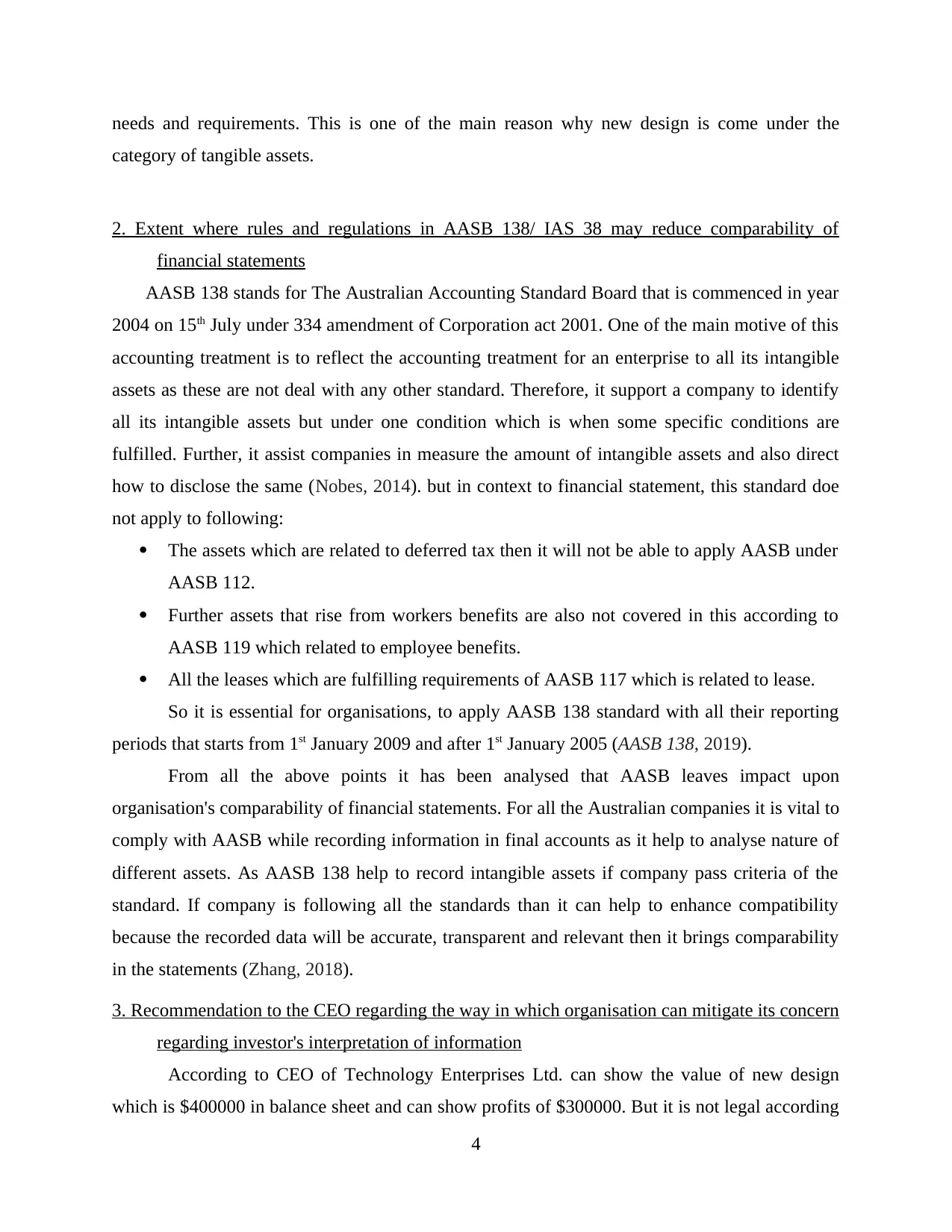
needs and requirements. This is one of the main reason why new design is come under the
category of tangible assets.
2. Extent where rules and regulations in AASB 138/ IAS 38 may reduce comparability of
financial statements
AASB 138 stands for The Australian Accounting Standard Board that is commenced in year
2004 on 15th July under 334 amendment of Corporation act 2001. One of the main motive of this
accounting treatment is to reflect the accounting treatment for an enterprise to all its intangible
assets as these are not deal with any other standard. Therefore, it support a company to identify
all its intangible assets but under one condition which is when some specific conditions are
fulfilled. Further, it assist companies in measure the amount of intangible assets and also direct
how to disclose the same (Nobes, 2014). but in context to financial statement, this standard doe
not apply to following:
The assets which are related to deferred tax then it will not be able to apply AASB under
AASB 112.
Further assets that rise from workers benefits are also not covered in this according to
AASB 119 which related to employee benefits.
All the leases which are fulfilling requirements of AASB 117 which is related to lease.
So it is essential for organisations, to apply AASB 138 standard with all their reporting
periods that starts from 1st January 2009 and after 1st January 2005 (AASB 138, 2019).
From all the above points it has been analysed that AASB leaves impact upon
organisation's comparability of financial statements. For all the Australian companies it is vital to
comply with AASB while recording information in final accounts as it help to analyse nature of
different assets. As AASB 138 help to record intangible assets if company pass criteria of the
standard. If company is following all the standards than it can help to enhance compatibility
because the recorded data will be accurate, transparent and relevant then it brings comparability
in the statements (Zhang, 2018).
3. Recommendation to the CEO regarding the way in which organisation can mitigate its concern
regarding investor's interpretation of information
According to CEO of Technology Enterprises Ltd. can show the value of new design
which is $400000 in balance sheet and can show profits of $300000. But it is not legal according
4
category of tangible assets.
2. Extent where rules and regulations in AASB 138/ IAS 38 may reduce comparability of
financial statements
AASB 138 stands for The Australian Accounting Standard Board that is commenced in year
2004 on 15th July under 334 amendment of Corporation act 2001. One of the main motive of this
accounting treatment is to reflect the accounting treatment for an enterprise to all its intangible
assets as these are not deal with any other standard. Therefore, it support a company to identify
all its intangible assets but under one condition which is when some specific conditions are
fulfilled. Further, it assist companies in measure the amount of intangible assets and also direct
how to disclose the same (Nobes, 2014). but in context to financial statement, this standard doe
not apply to following:
The assets which are related to deferred tax then it will not be able to apply AASB under
AASB 112.
Further assets that rise from workers benefits are also not covered in this according to
AASB 119 which related to employee benefits.
All the leases which are fulfilling requirements of AASB 117 which is related to lease.
So it is essential for organisations, to apply AASB 138 standard with all their reporting
periods that starts from 1st January 2009 and after 1st January 2005 (AASB 138, 2019).
From all the above points it has been analysed that AASB leaves impact upon
organisation's comparability of financial statements. For all the Australian companies it is vital to
comply with AASB while recording information in final accounts as it help to analyse nature of
different assets. As AASB 138 help to record intangible assets if company pass criteria of the
standard. If company is following all the standards than it can help to enhance compatibility
because the recorded data will be accurate, transparent and relevant then it brings comparability
in the statements (Zhang, 2018).
3. Recommendation to the CEO regarding the way in which organisation can mitigate its concern
regarding investor's interpretation of information
According to CEO of Technology Enterprises Ltd. can show the value of new design
which is $400000 in balance sheet and can show profits of $300000. But it is not legal according
4
Paraphrase This Document
Need a fresh take? Get an instant paraphrase of this document with our AI Paraphraser
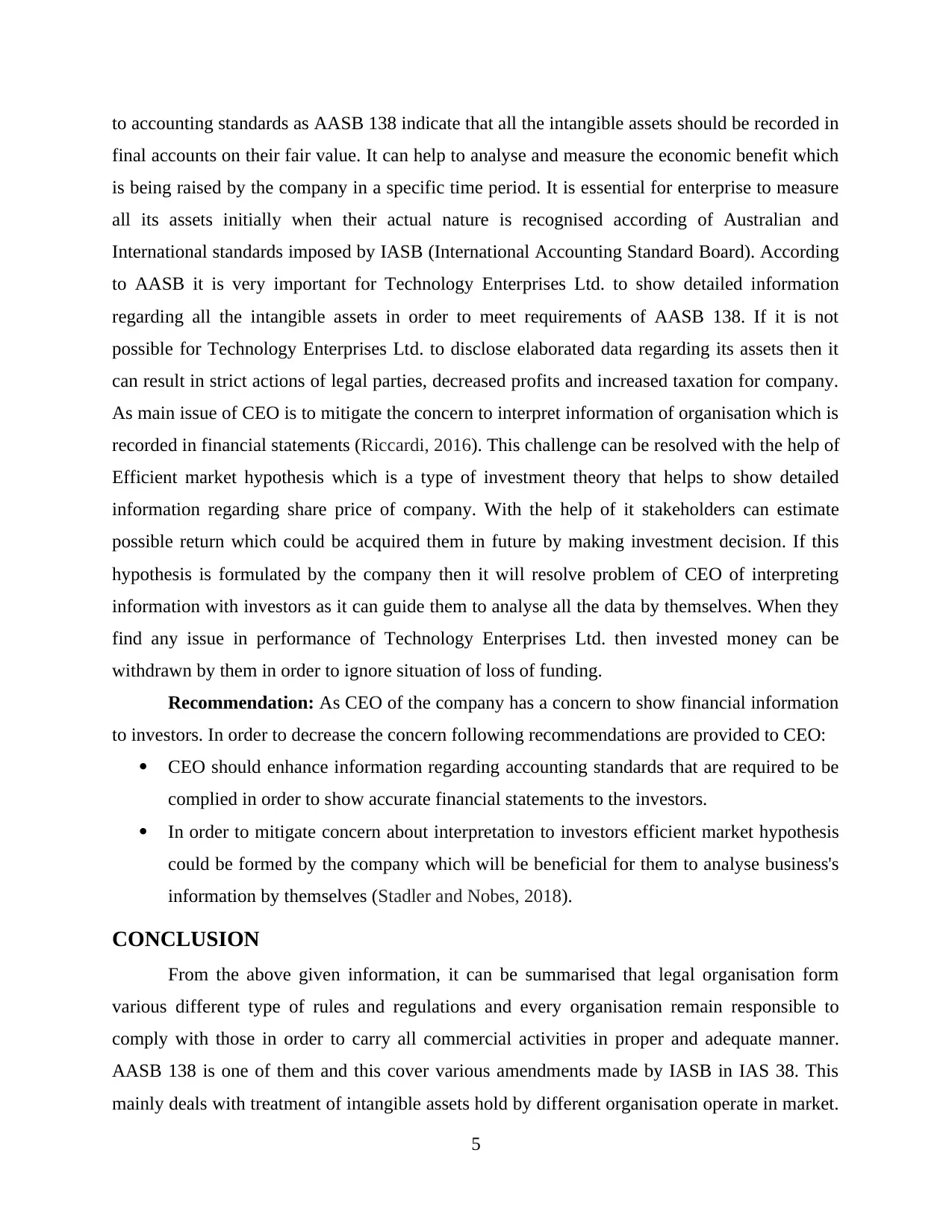
to accounting standards as AASB 138 indicate that all the intangible assets should be recorded in
final accounts on their fair value. It can help to analyse and measure the economic benefit which
is being raised by the company in a specific time period. It is essential for enterprise to measure
all its assets initially when their actual nature is recognised according of Australian and
International standards imposed by IASB (International Accounting Standard Board). According
to AASB it is very important for Technology Enterprises Ltd. to show detailed information
regarding all the intangible assets in order to meet requirements of AASB 138. If it is not
possible for Technology Enterprises Ltd. to disclose elaborated data regarding its assets then it
can result in strict actions of legal parties, decreased profits and increased taxation for company.
As main issue of CEO is to mitigate the concern to interpret information of organisation which is
recorded in financial statements (Riccardi, 2016). This challenge can be resolved with the help of
Efficient market hypothesis which is a type of investment theory that helps to show detailed
information regarding share price of company. With the help of it stakeholders can estimate
possible return which could be acquired them in future by making investment decision. If this
hypothesis is formulated by the company then it will resolve problem of CEO of interpreting
information with investors as it can guide them to analyse all the data by themselves. When they
find any issue in performance of Technology Enterprises Ltd. then invested money can be
withdrawn by them in order to ignore situation of loss of funding.
Recommendation: As CEO of the company has a concern to show financial information
to investors. In order to decrease the concern following recommendations are provided to CEO:
CEO should enhance information regarding accounting standards that are required to be
complied in order to show accurate financial statements to the investors.
In order to mitigate concern about interpretation to investors efficient market hypothesis
could be formed by the company which will be beneficial for them to analyse business's
information by themselves (Stadler and Nobes, 2018).
CONCLUSION
From the above given information, it can be summarised that legal organisation form
various different type of rules and regulations and every organisation remain responsible to
comply with those in order to carry all commercial activities in proper and adequate manner.
AASB 138 is one of them and this cover various amendments made by IASB in IAS 38. This
mainly deals with treatment of intangible assets hold by different organisation operate in market.
5
final accounts on their fair value. It can help to analyse and measure the economic benefit which
is being raised by the company in a specific time period. It is essential for enterprise to measure
all its assets initially when their actual nature is recognised according of Australian and
International standards imposed by IASB (International Accounting Standard Board). According
to AASB it is very important for Technology Enterprises Ltd. to show detailed information
regarding all the intangible assets in order to meet requirements of AASB 138. If it is not
possible for Technology Enterprises Ltd. to disclose elaborated data regarding its assets then it
can result in strict actions of legal parties, decreased profits and increased taxation for company.
As main issue of CEO is to mitigate the concern to interpret information of organisation which is
recorded in financial statements (Riccardi, 2016). This challenge can be resolved with the help of
Efficient market hypothesis which is a type of investment theory that helps to show detailed
information regarding share price of company. With the help of it stakeholders can estimate
possible return which could be acquired them in future by making investment decision. If this
hypothesis is formulated by the company then it will resolve problem of CEO of interpreting
information with investors as it can guide them to analyse all the data by themselves. When they
find any issue in performance of Technology Enterprises Ltd. then invested money can be
withdrawn by them in order to ignore situation of loss of funding.
Recommendation: As CEO of the company has a concern to show financial information
to investors. In order to decrease the concern following recommendations are provided to CEO:
CEO should enhance information regarding accounting standards that are required to be
complied in order to show accurate financial statements to the investors.
In order to mitigate concern about interpretation to investors efficient market hypothesis
could be formed by the company which will be beneficial for them to analyse business's
information by themselves (Stadler and Nobes, 2018).
CONCLUSION
From the above given information, it can be summarised that legal organisation form
various different type of rules and regulations and every organisation remain responsible to
comply with those in order to carry all commercial activities in proper and adequate manner.
AASB 138 is one of them and this cover various amendments made by IASB in IAS 38. This
mainly deals with treatment of intangible assets hold by different organisation operate in market.
5
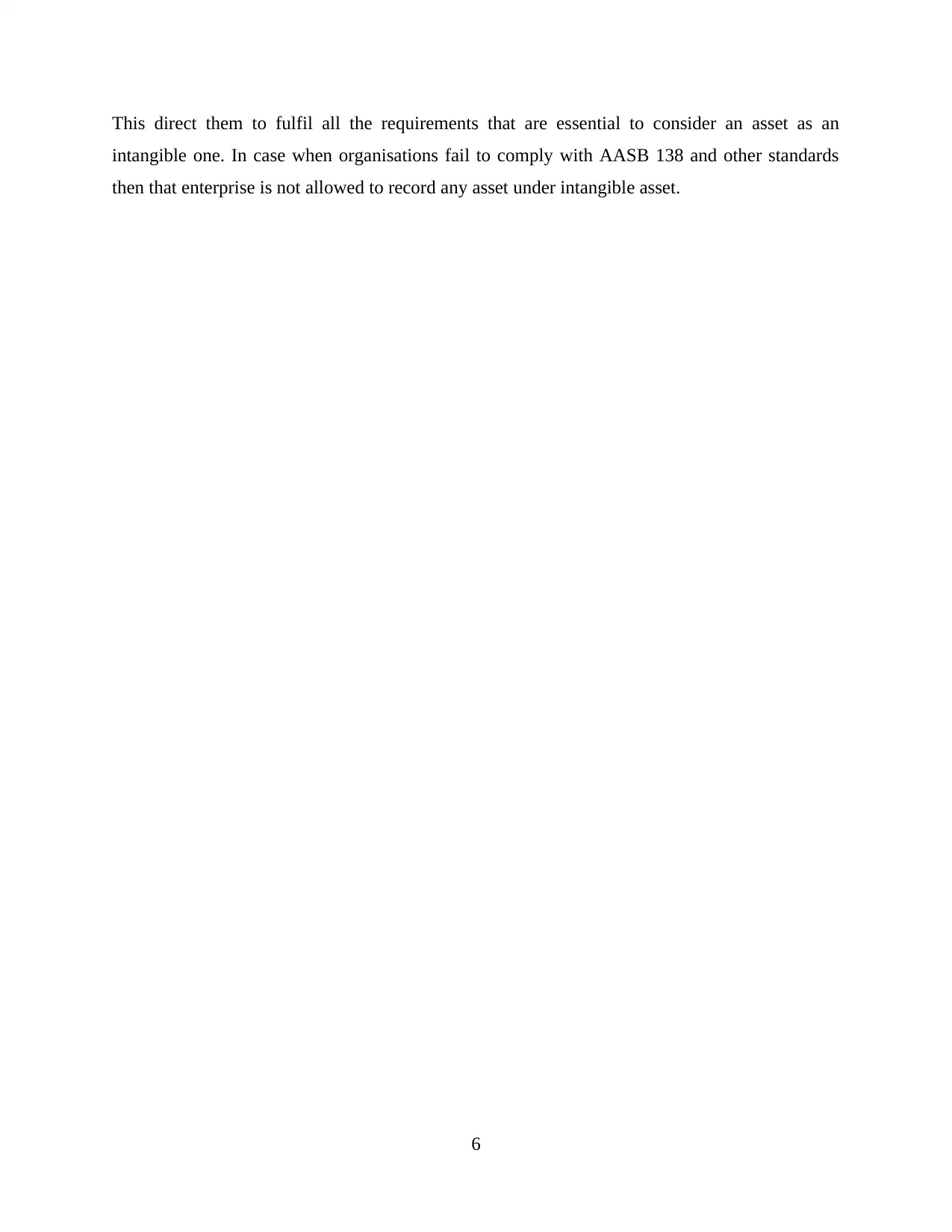
This direct them to fulfil all the requirements that are essential to consider an asset as an
intangible one. In case when organisations fail to comply with AASB 138 and other standards
then that enterprise is not allowed to record any asset under intangible asset.
6
intangible one. In case when organisations fail to comply with AASB 138 and other standards
then that enterprise is not allowed to record any asset under intangible asset.
6
⊘ This is a preview!⊘
Do you want full access?
Subscribe today to unlock all pages.

Trusted by 1+ million students worldwide
1 out of 9
Related Documents
Your All-in-One AI-Powered Toolkit for Academic Success.
+13062052269
info@desklib.com
Available 24*7 on WhatsApp / Email
![[object Object]](/_next/static/media/star-bottom.7253800d.svg)
Unlock your academic potential
Copyright © 2020–2025 A2Z Services. All Rights Reserved. Developed and managed by ZUCOL.





